Recovering the American chestnut
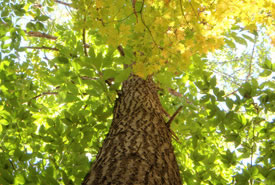
American chestnut (Photo by Norfolk County)
The Canadian Chestnut Council (CCC) is a volunteer-run scientific and charitable organization. Now in its 29th year, CCC's goal is to save the endangered American chestnut from extinction. The American chestnut was once the dominant hardwood species in the Carolinian forest and an important food source for Indigenous people.
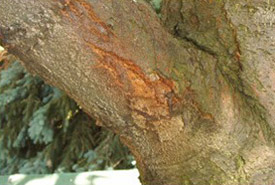
Canker on American chestnut (Photo by CCC)
This super canopy tree's top branches once rose above all other species in the forest. Often referred to as the eastern redwood, this species was at one time a major source of rot-resistant timber for everything from cradles to coffins. In the mid-1920s, a fungal disease, the invasive chestnut blight, swept into Ontario from New York State. The blight killed approximately two million trees, leaving just a few isolated chestnuts as survivors. The loss of this species impacted about 275 other species that relied on American chestnuts for part of their life cycle. Some of the recorded extinctions include:
- chestnut ermine moth
- chestnut casebearer
- phelophagan chestnut moth
- American chestnut moth
Losing the American chestnut caused a ripple in the food web that is still felt today. It had far-reaching effects that caused population declines for many species.
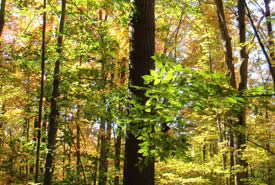
American Chestnut (Photo by Norfolk County)
The CCC hopes to restore the American chestnut to its former cultural, ecological and economic roles in Ontario. To that end, CCC works to preserve the remaining genetics of the Canadian population of American chestnuts and breed a blight-resistant pure American chestnut of Canadian origin.
The conservation of the remaining native population is being achieved in two CCC-led projects: the Breaking Isolation and Gene Pods projects.
Breaking isolation
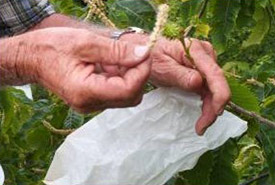
Attaching bags to American chestnut tree to collect pollen (Photo by CCC)
Although there still remain American chestnut trees in Ontario, they are so isolated that they cannot cross-pollinate and produce seeds. The Breaking Isolation project aims to address this problem. An isolated wild chestnut lacks a partner to exchange pollen with. Instead, it flowers and produces burrs with no nuts. This has been occurring for over 90 years for some of our larger trees. To break this isolation, the CCC provides the wild tree with genetically different native partners. They provide the necessary pollen for cross-pollination and the production of viable nuts of greater genetic diversity in the new group planting.
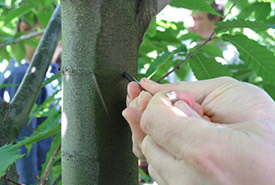
Trees are infected with blight (Photo by CCC)
We have grown new partner trees using a process called “etiolated grafting.” This involves taking a small cutting from a mature American chestnut tree that has demonstrated resistance to chestnut blight. The live twigs are then grafted to germinated native chestnut nuts from another native parent tree. Six to 12 of these little grafted trees are planted close to naturally occurring, mature American chestnut trees.
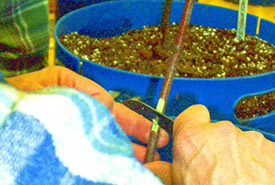
Grafting chestnut softwood cuttings (Photo by CCC)
Although these grafted trees are small, they behave as though they are much older, because a mature twig is used in the grafting process. This allows the grafted trees to flower in their second year! Pollen produced by the grafted trees allows the naturally occurring tree to once again produce fertile nuts, breaking the natural trees’ former isolation.
This is the first step in recovering American chestnuts in the wild and conserving native genetics.
Gene pods
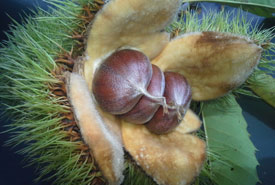
Example of viable chestnut (Photo by CCC)
In areas without native chestnut trees, CCC works to establish “gene pods.” Volunteers plant groups of chestnut trees from a variety of native genetic sources, either in a pure chestnut grouping or intermixed with other native species, such as white pine and red oak. Additional chestnut from other native genetic sources are added, until we establish a pod of 100 to 200 chestnuts. The mixture allows for maximum cross-pollination within the species, increasing the genetic diversity.
In both the Breaking Isolation and the Gene Pods projects, the nuts that the trees produce will support wildlife, as they did in the years before chestnut blight. Some of these nuts will escape being eaten and will germinate to produce young trees.
In partnership with the Nature Conservancy of Canada (NCC), we have already established two gene pods in Norfolk County in the 2017 growing season. The CCC looks forward to growing these initial projects and expanding the recovery of the American chestnut on NCC properties throughout the Carolinian forest in 2018.
A promising future
After 17 years of breeding for native blight resistance in our Canadian American chestnut, our first- and second-generation of trees have produced individuals, demonstrating progressive blight-resistance qualities. With a third generation scheduled for late 2018, the ability to produce a highly blight-resistant tree is promising…but not guaranteed.
To learn about additional American chestnut projects by the Canadian Chestnut Council, visit canadianchestnutcouncil.ca.


